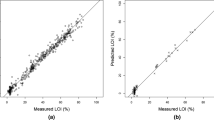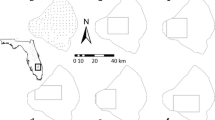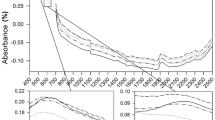Abstract
We developed an inference model to infer dissolved organic carbon (DOC) in lakewater from lake sediments using visible-near-infrared spectroscopy (VNIRS). The inference model used surface sediment samples collected from 160 Arctic Canada lakes, covering broad latitudinal (60–83°N), longitudinal (71–138°W) and environmental gradients, with a DOC range of 0.6–39.6 mg L−1. The model was applied to Holocene lake sediment cores from Sweden and Canada and our inferences are compared to results from previous multiproxy paleolimnological investigations at these two sites. The inferred Swedish and Canadian DOC profiles are compared, respectively, to inferences from a Swedish-based VNIRS-total organic carbon (TOC) model and a Canadian-based diatom-inferred (Di-DOC) model from the same sediment records. The 5-component Partial Least Squares (PLS) model yields a cross-validated (CV) \( R_{CV}^{2} \) = 0.61 and a root mean squared error of prediction (RMSEP CV ) = 4.4 mg L−1 (11% of DOC gradient). The trends inferred for the two lakes were remarkably similar to the VNIRS-TOC and the Di-DOC inferred profiles and consistent with the other paleolimnological proxies, although absolute values differed. Differences in the calibration set gradients and lack of analogous VNIRS signatures in the modern datasets may explain this discrepancy. Our results corroborate previous geographically independent studies on the potential of using VNIRS to reconstruct past trends in lakewater DOC concentrations rapidly.





Similar content being viewed by others
References
ACIA (2005) Arctic climate impact assessment. Cambridge University Press, Cambridge
Birks HH, Birks HJB (2006) Multi-proxy studies in palaeolimnology. Veg Hist Archaeobot 15:235–251
CAVM Team (2003) Circumpolar arctic vegetation map. Conservation of Arctic Flora and Fauna (CAFF) Map No. 1 [map]. 1:7,500,000. US Fish and Wildlife Service, Anchorage, USA
Cole JJ, Prairie YT, Caraco NF, Mcdowell WH, Tranvik LJ, Striegl RG, Duarte CM, Kortelainen P, Downing JA, Middelburg JJ, Melack J (2007) Plumbing the global carbon cycle: integrating inland waters into the terrestrial carbon budget. Ecosystems 10:172–185
Côté G, Pienitz R, Velle G, Wang X (2010) Impact of Geese on the Limnology of Lakes and Ponds from Bylot Island (Nunavut, Canada). Intern Rev Hydrobiol 95:105–129
Cunningham L, Bishop K, Mettävainio E, Rosén P (2011) Paleoecological evidence of major declines in total organic carbon concentrations since the nineteenth century in four nemoboreal lakes. J Paleolimnol 45:507–518
Curtis CJ, Juggins S, Clarke G, Battarbee R, Kernan M, Catalan J, Thompson R, Posch M (2009) Regional influence of acid deposition and climate change in European mountain lakes assessed using diatom transfer functions. Freshw Biol 54:2555–2572
den Heyer C, Kalff J (1998) Organic matter mineralization rates in sediments: a within-and among-lake study. Limnol Oceanogr 43:695–705
Douglas MSV, Smol JP (1994) Limnology of high arctic ponds (Cape Herschel, Ellesmere Island, N.W.T). Arch Hydrobiol 131:401–434
Ecological Working Group (2002) The State of Canada’s ecosystems in maps [map]. 1:2,500,000. Ecological Mapping Analysis and Protocols, Government of Canada, Ottawa, Canada
Environment Canada (1979) Analytical methods manual. Inland Waters Directorate, Water Quality Branch, Ottawa, Canada
Environment Canada (1994a) Manual for analytical methods, vol 1-major ions and nutrients. National Laboratory for Environmental Testing, Canadian Centre for Inland Waters, Burlington
Environment Canada (1994b) Manual for analytical methods, vol 2-trace metals. National Laboratory for Environmental Testing, Canadian Centre for Inland Waters, Burlington
Fallu M, Pienitz R (1999) Diatomées lacustres de Jamésie-Hudsonie (Québec) et modèle de reconstitution des concentrations de carbone organique dissous. Écoscience 6:603–620
Frey KE, McClelland JW (2009) Impacts of permafrost degradation on arctic river biogeochemistry. Hydrol Process 23:169–182
Geladi P, Macdougall D, Martens H (1985) Linearization and scatter-correction for near-infrared reflectance spectra of meat. Appl Spectrosc 39:491–500
GeoBase (2007) National hydro Network (NHN) [web database]. 1:50,000. Centre for Topographic Information, Geomatics Canada, Earth Sciences Sector, Natural Resources Canada, Sherbrooke, Canada
Geological Survey of Canada (GSC) (1973) Surface Materials [map]. 1:15,000,000. The National Atlas of Canada. Surveys and Mapping Branch, Department of Energy, Mines and Resources, Ottawa, Canada, pp 37–38
Geological Survey of Canada (GSC) (2002a) Canadian peatland database [web database]. 1:6,500,000. Earth Sciences Sector, Terrain Sciences Division, Natural Resources Canada, Ottawa, Canada
Geological Survey of Canada (GSC) (2002b) Canadian permafrost thickness [web database]. Earth Sciences Sector, Natural Resources Canada, Ottawa
Jansson M, Hickler T, Jonsson A, Karlsson J (2008) Links between terrestrial primary production and bacterial production and respiration in lakes in a climate gradient in subarctic Sweden. Ecosystems 11:367–376
Karlsson J, Byström P, Ask J, Ask P, Persson L, Jansson M (2009) Light limitation of nutrient-poor lake ecosystems. Nature 460:506–509
Keatley BE, Douglas MSV, Smol JP (2007a) Limnological characteristics of a high arctic oasis and comparisons across northern Ellesmere Island. Arctic 60:294–308
Keatley BE, Douglas MSV, Smol JP (2007b) Physical and chemical limnological characteristics of lakes and ponds across environmental gradients on Melville Island, Nunavut/NWT, High Arctic Canada. Fundam Appl Limnol 168:355–376
Kokelj S, Jenkins R, Milburn D, Burn C, Snow N (2005) The influence of thermokarst disturbance on the water quality of small upland lakes, Mackenzie Delta Region, Northwest Territories, Canada. Permafr Periglac Process 16:343–353
Kokfelt U, Rosén P, Schoning K, Christensen T, Förster J, Karlsson J, Reuss N, Rundgren M, Callaghan T, Jonasson C, Hammarlund D (2009) Ecosystem responses to increased precipitation and permafrost decay in sub-arctic Sweden inferred from peat and lake sediments. Glob Chang Biol 15:1652–1663
Korsman T, Nilsson M, Ohman J, Renberg I (1992) Near-infrared reflectance spectroscopy of sediments—a potential method to infer the past pH of lakes. Environ Sci Technol 26:2122–2126
Korsman T, Renberg I, Dabakk E, Nilsson MB (2001) Near-infrared spectrometry (NIRS) in palaeolimnology. In: Last WM, Smol JP (eds) Physical and geochemical methods. Kluwer, Dordrecht, pp 299–317
Leavitt P, Cumming BF, Smol JP, Reasoner M, Pienitz R, Hodgson D (2003) Climatic control of ultraviolet radiation effects on lakes. Limnol Oceanogr 48:2062–2069
Lim DSS, Douglas MSV (2003) Limnological characteristics of 22 lakes and ponds in the Haughton Crater region of Devon Island, Nunavut, Canadian High Arctic. Arct Antarct Alp Res 35:509–519
Lim DSS, Douglas MSV, Smol JP, Lean DRS (2001) Physical and chemical limnological characteristics of 38 lakes and ponds on Bathurst Island, Nunavut, Canadian High Arctic. Int Rev Hydrobiol 86:1–22
Lim DSS, Douglas MSV, Smol JPS (2005) Limnology of 46 lakes and ponds on Banks Island, NWT, Canadian Arctic Archipelago. Hydrobiologia 545:11–32
Michelutti N, Douglas MSV, Lean DRS, Smol JP (2002a) Physical and chemical limnology of 34 ultra-oligotrophic lakes and ponds near Wynniatt Bay, Victoria Island, Arctic Canada. Hydrobiologia 482:1–13
Michelutti N, Douglas MSV, Muir D, Wang X, Smol JP (2002b) Limnological characteristics of 38 lakes and ponds on Axel Heiberg Island, High Arctic Canada. Int Rev Hydrobiol 87:385–399
Michelutti N, Douglas MSV, Wolfe AP, Smol JP (2006) Heightened sensitivity of a poorly buffered high arctic lake to late-Holocene climatic change. Quat Res 65:421–430
Michelutti N, Douglas MSV, Smol JP (2007) Evaluating diatom community composition in the absence of marked limnological gradients in the high Arctic: a surface sediment calibration set from Cornwallis Island (Nunavut, Canada). Polar Biol 30:1459–1473
Michelutti N, Blais JM, Cumming BF, Paterson AM, Rühland KM, Wolfe AP, Smol JP (2010) Do spectrally inferred determinations of chlorophyll a reflect trends in lake trophic status? J Paleolimnol 43:205–217
Monteith DT, Stoddard JL, Evans CD, de Wit HA, Forsius M, Høgåsen T, Wilander A, Skjelkvåle BL, Jeffries DS, Vuorenmaa J, Keller B, Kopácek J, Vesely J (2007) Dissolved organic carbon trends resulting from changes in atmospheric deposition chemistry. Nature 450:537–540
Pienitz R, Smol JP (1993) Diatom assemblages and their relationship to environmental variables in lakes from the boreal forest-tundra ecotone near Yellowknife, Northwest-Territories, Canada. Hydrobiologia 269:391–404
Pienitz R, Smol JP, Lean DRS (1997a) Physical and chemical limnology of 24 lakes located between Yellowknife and Contwoyto Lake, Northwest Territories (Canada). Can J Fish Aquat Sci 54:347–358
Pienitz R, Smol JP, Lean DRS (1997b) Physical and chemical limnology of 59 lakes located between the southern Yukon and the Tuktoyaktuk Peninsula, Northwest Territories (Canada). Can J Fish Aquat Sci 54:330–346
Pienitz R, Smol JP, Macdonald GM (1999) Paleolimnological reconstruction of Holocene climatic trends from two boreal treeline lakes, Northwest Territories, Canada. Arct Antarct Alp Res 31:82–93
Reuss NS, Hammarlund D, Rundgren M, Segerström U, Eriksson L, Rosén P (2010) Lake ecosystem responses to Holocene climate change at the subarctic tree-line in Northern Sweden. Ecosystems 13:393–409
Rinnan R, Michelsen A, Jonasson S (2008) Effects of litter addition and warming on soil carbon, nutrient pools and microbial communities in a subarctic heath ecosystem. Appl Soil Ecol 39:271–281
Rosén P (2005) Total organic carbon (TOC) of lake water during the Holocene inferred from lake sediments and near-infrared spectroscopy (NIRS) in eight lakes from northern Sweden. Biogeochemistry 76:503–516
Rosén P, Hammarlund D (2007) Effects of climate, fire and vegetation development on Holocene changes in total organic carbon concentration in three boreal forest lakes in northern Sweden. Biogeosciences 4:975–984
Rosén P, Persson P (2006) Fourier-transform infrared spectroscopy (FTIRS), a new method to infer past changes in tree-line position and TOC using lake sediment. J Paleolimnol 35:913–923
Rosén P, Hall R, Korsman T, Renberg I (2000a) Diatom transfer-functions for quantifying past air temperature, pH and total organic carbon concentration from lakes in northern Sweden. J Paleolimnol 24:109–123
Rosén P, Dabakk E, Renberg I, Nilsson M, Hall R (2000b) Near-infrared spectrometry (NIRS): a new tool for inferring past climatic changes from lake sediments. Holocene 10:161–166
Rosén P, Segerström U, Eriksson L, Renberg I, Birks HJB (2001) Holocene climatic change reconstructed from diatoms, chironomids, pollen and near-infrared spectroscopy at an alpine lake (Sjuodjljaure) in northern Sweden. Holocene 11:551–562
Rosén P, Segerström U, Eriksson L, Renberg I (2003) Do diatom, chironomid, and pollen records consistently infer Holocene July air temperature? A comparison using sediment cores from four alpine lakes in northern Sweden. Arct Antarct Alp Res 35:279–290
Rosén P, Vogel H, Cunningham L, Reuss N, Conley DJ, Persson P (2010) Fourier transform infrared spectroscopy, a new method for rapid determination of total organic and inorganic carbon and biogenic silica concentration in lake sediments. J Paleolimnol 43:247–259
Rühland KM (2001) Diatom Assemblage shifts relative to changes in environmental and climatic conditions in the circumpolar treeline regions of the Canadian and Siberian Arctic. PhD thesis, Department of Biology, Queen’s University, pp 124–150
Rühland KM, Smol JP (2002) Freshwater diatoms from the Canadian Arctic treeline and development of paleolimnological inference models. J Phycol 38:249–264
Rühland KM, Smol JP (2005) Diatom shifts as evidence for recent subarctic warming in a remote tundra lake, NWT, Canada. Palaeogeogr Palaeoclimatol Palaeoecol 226:1–16
Soil Landscapes of Canada Working Group (2006) Soil landscapes of Canada, v3.1 [map]. 1:1,000,000. Agriculture and Agri-Food Canada, Ottawa, Canada
Sweetman JN, Laface E, Rühland KM, Smol JP (2008) Evaluating the response of cladocera to recent environmental changes in lakes from the Central Canadian Arctic treeline region. Arct Antarct Alp Res 40:584–591
Thorsteinsson R, Tozer ET (1970) Geology of the Arctic Archipelago. In: Douglas, RJW (ed) Geology and economic minerals of Canada. Geological Survey of Canada, Economic Geology Report, Ottawa, pp 547–590
Vincent WF, Laybourn-Parry J (2008) Polar lakes and rivers: limnology of Arctic and Antarctic aquatic ecosystems. Oxford University Press, Oxford
Acknowledgments
This study was funded by the NSERC (Ottawa, Canada), CIRC, Umeå University and through the CGS-MSFSS program. We thank J. Thienpont, M. Pisaric and S. Kokelj for providing the Inuvik sediments, as well as the many field crews who assisted in various sampling programs. We also thank K. Rühland for sharing data and knowledge on Slipper Lake, A. Holmgren for her help with the VNIRS analyses in Umeå, C. Grooms for his technical assistance, N. Michelutti and the PEARL, CEN, CIRC and EMG research groups for their support, as well as B. F. Cumming and S. Lamoureux and two anonymous reviewers for their constructive comments on the manuscript.
Author information
Authors and Affiliations
Corresponding author
Electronic supplementary material
Below is the link to the electronic supplementary material.
Rights and permissions
About this article
Cite this article
Rouillard, A., Rosén, P., Douglas, M.S.V. et al. A model for inferring dissolved organic carbon (DOC) in lakewater from visible-near-infrared spectroscopy (VNIRS) measures in lake sediment. J Paleolimnol 46, 187–202 (2011). https://doi.org/10.1007/s10933-011-9527-8
Received:
Accepted:
Published:
Issue Date:
DOI: https://doi.org/10.1007/s10933-011-9527-8




